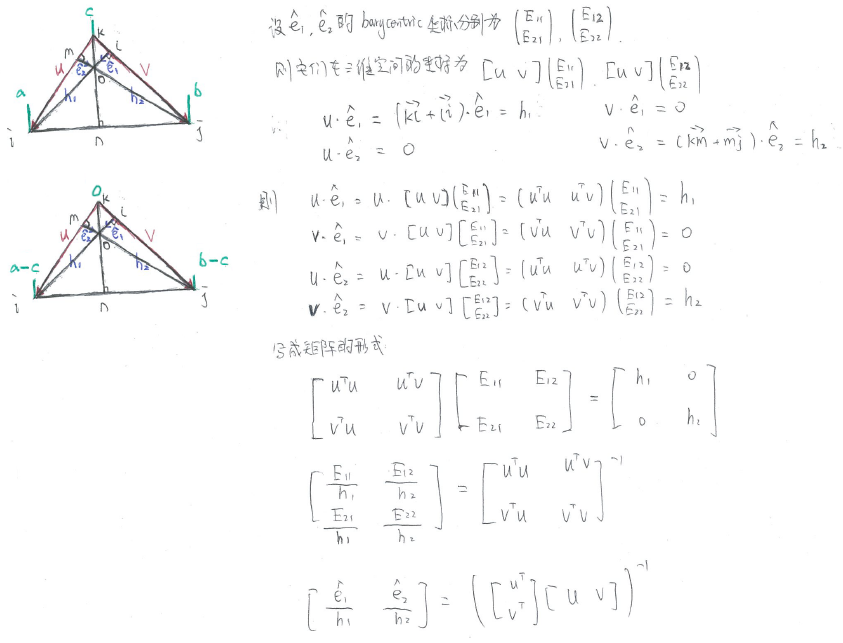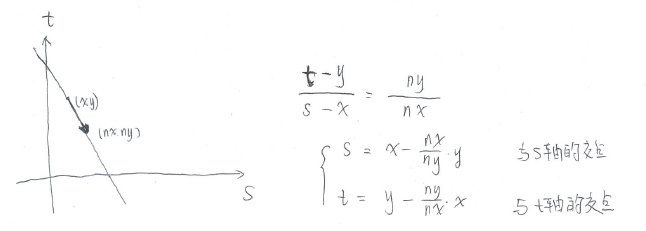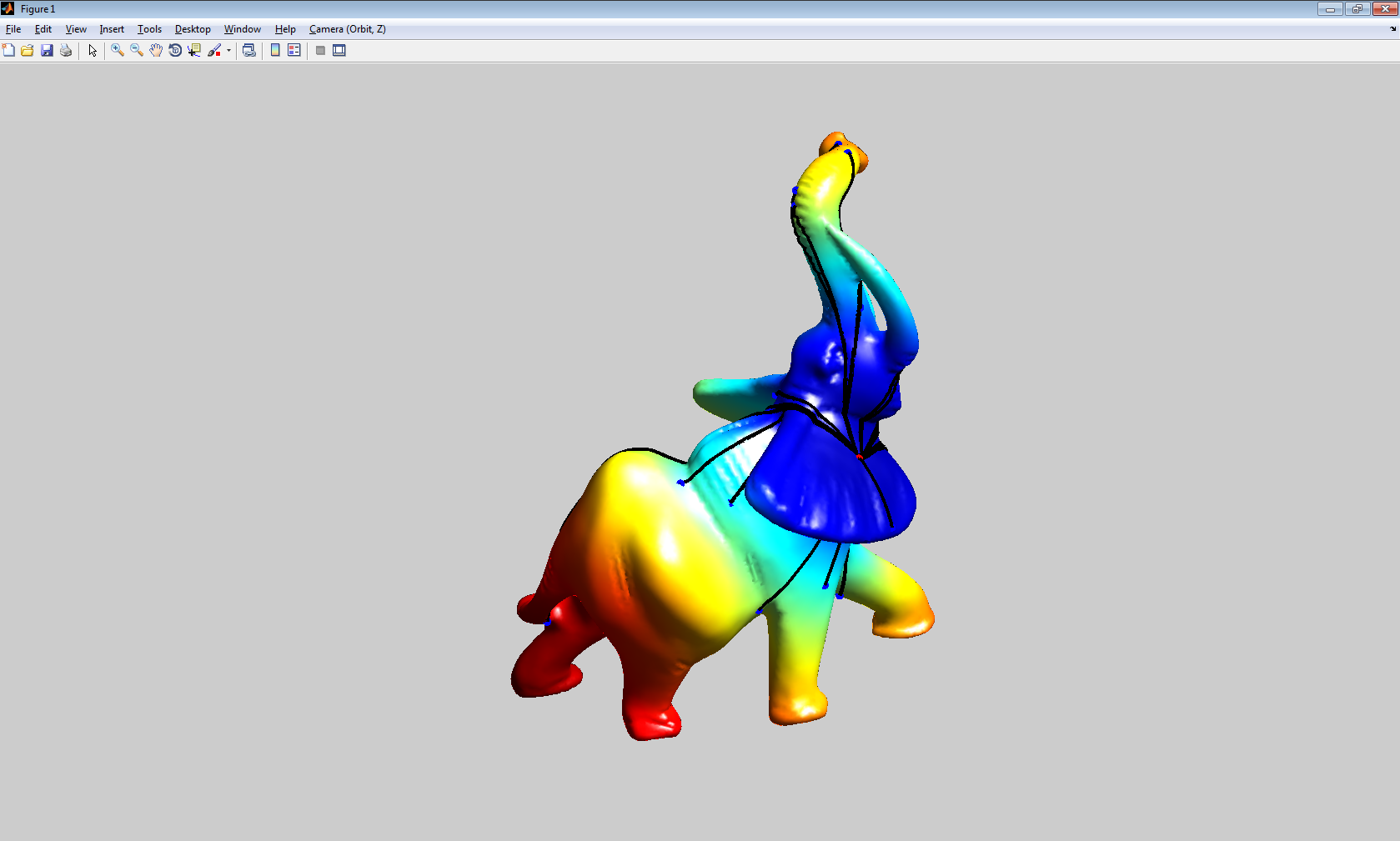3D mesh的fast marching 跟2D图片的fast marching类似.
2D图片是规则的平面网格,点的
ux,uy
是通过上或下,左或右(具体哪个,是通过距离小的点去确定),具体请参考
http://blog.csdn.net/seamanj/article/details/51991067
而3D mesh上点的
ux,uy
是通过与它位于同一个三角形的其他两个点去确定
在本例中,W(也就是weight)全为1,这里可以理解为流速F
u为距离D,即我们要求的
Δx
,
Δy
分别为点到它两个父节点的距离
这样,根据2D情况中的公式就可以求出每个点的距离了,最终求出D
下面给出关于求D的关键代码
/*------------------------------------------------------------------------------*/
// Name : GW_GeodesicMesh::PerformFastMarchingOneStep
/**
* \return [GW_Bool] Is the marching process finished ?
* \author Gabriel Peyr�
* \date 4-13-2003
*
* Just one update step of the marching algorithm.
*/
/*------------------------------------------------------------------------------*/
GW_INLINE
GW_Bool GW_GeodesicMesh::PerformFastMarchingOneStep()
{
if( ActiveVertex_.empty() )
return GW_True;
GW_ASSERT( bIsMarchingBegin_ );
// std::make_heap( ActiveVertex_.begin(), ActiveVertex_.end(), GW_GeodesicVertex::CompareVertex );
GW_GeodesicVertex* pCurVert = ActiveVertex_.front();
GW_ASSERT( pCurVert!=NULL );
std::pop_heap( ActiveVertex_.begin(), ActiveVertex_.end(), GW_GeodesicVertex::CompareVertex );
ActiveVertex_.pop_back();
pCurVert->SetState( GW_GeodesicVertex::kDead );
if( NewDeadVertexCallback_!=NULL )
NewDeadVertexCallback_( *pCurVert );
#if 0 // just for debug
for( IT_GeodesicVertexVector it = ActiveVertex_.begin(); it!=ActiveVertex_.end(); ++it )
GW_ASSERT( pCurVert->GetDistance()<=(*it)->GetDistance() );
#endif
for( GW_VertexIterator VertIt = pCurVert->BeginVertexIterator(); VertIt!=pCurVert->EndVertexIterator(); ++VertIt )
{
GW_GeodesicVertex* pNewVert = (GW_GeodesicVertex*) *VertIt;
GW_ASSERT( pNewVert!=NULL );
/* compute it's new value */
if( pCurVert->GetIsStoppingVertex() && !pNewVert->GetIsStoppingVertex() && pNewVert->GetState()==GW_GeodesicVertex::kFar )
{
// this vertex is not allowed to add alive vertex that are not stopping.
}
else
{
/* compute it's new distance using neighborhood information */
GW_Float rNewDistance = GW_INFINITE;
for( GW_FaceIterator FaceIt=pNewVert->BeginFaceIterator(); FaceIt!=pNewVert->EndFaceIterator(); ++FaceIt )
//该循环找出与点距离最近两个父节点,因为点不是按mesh的边走,可以穿过边到达,那么穿过边的两个端点即为该点的两个父节点
{
GW_GeodesicFace* pFace = (GW_GeodesicFace*) *FaceIt;
GW_ASSERT( pFace!=NULL );
GW_GeodesicVertex* pVert1 = (GW_GeodesicVertex*) pFace->GetNextVertex( *pNewVert );
GW_ASSERT( pVert1!=NULL );
GW_GeodesicVertex* pVert2 = (GW_GeodesicVertex*) pFace->GetNextVertex( *pVert1 );
GW_ASSERT( pVert2!=NULL );
if( pVert1->GetDistance()> pVert2->GetDistance() )
{
GW_GeodesicVertex* pTempVert = pVert1;
pVert1 = pVert2;
pVert2 = pTempVert;
}
rNewDistance = GW_MIN( rNewDistance, this->ComputeVertexDistance( *pFace, *pNewVert, *pVert1, *pVert2, *pCurVert->GetFront() ) );
}
switch( pNewVert->GetState() ) {
case GW_GeodesicVertex::kFar:
/* ask to the callback if we should update this vertex and add it to the path */
if( VertexInsersionCallback_==NULL ||
VertexInsersionCallback_( *pNewVert,rNewDistance ) )
{
pNewVert->SetDistance( rNewDistance );
/* add the vertex to the heap */
ActiveVertex_.push_back( pNewVert );
std::push_heap( ActiveVertex_.begin(), ActiveVertex_.end(), GW_GeodesicVertex::CompareVertex );
/* this one can be added to the heap */
pNewVert->SetState( GW_GeodesicVertex::kAlive );
pNewVert->SetFront( pCurVert->GetFront() );
}
break;
case GW_GeodesicVertex::kAlive:
/* just update it's value */
if( rNewDistance<=pNewVert->GetDistance() )
{
/* possible overlap with old value */
if( pCurVert->GetFront()!=pNewVert->GetFront() )
pNewVert->GetFrontOverlapInfo().RecordOverlap( *pNewVert->GetFront(), pNewVert->GetDistance() );
pNewVert->SetDistance( rNewDistance );
pNewVert->SetFront( pCurVert->GetFront() );
// hum, check if we can correct this (avoid recomputing the whole heap).
std::make_heap( ActiveVertex_.begin(), ActiveVertex_.end(), GW_GeodesicVertex::CompareVertex );
}
else
{
/* possible overlap with new value */
if( pCurVert->GetFront()!=pNewVert->GetFront() )
pNewVert->GetFrontOverlapInfo().RecordOverlap( *pCurVert->GetFront(), rNewDistance );
}
break;
case GW_GeodesicVertex::kDead:
/* inform the user if there is an overlap */
if( pCurVert->GetFront()!=pNewVert->GetFront() )
pNewVert->GetFrontOverlapInfo().RecordOverlap( *pCurVert->GetFront(), rNewDistance );
break;
default:
GW_ASSERT( GW_False );
}
}
}
/* have we finished ? */
bIsMarchingEnd_ = ActiveVertex_.empty();
/* the user can force ending of the algorithm */
if( ForceStopCallback_!=NULL && bIsMarchingEnd_==GW_False )
bIsMarchingEnd_ = ForceStopCallback_(*pCurVert);
return bIsMarchingEnd_;
}
/*------------------------------------------------------------------------------*/
// Name : GW_GeodesicMesh::ComputeVertexDistance
/**
* \param CurrentVertex [GW_GeodesicVertex&] The vertex to update.
* \param Vert1 [GW_GeodesicVertex&] It's 1st neighbor.
* \param Vert2 [GW_GeodesicVertex&] 2nd vertex.
* \return The value of the distance according to this triangle contribution.
* \author Gabriel Peyr�
* \date 4-12-2003
*
* Compute the update of a vertex from inside of a triangle.
*/
/*------------------------------------------------------------------------------*/
GW_INLINE
GW_Float GW_GeodesicMesh::ComputeVertexDistance( GW_GeodesicFace& CurrentFace, GW_GeodesicVertex& CurrentVertex,
GW_GeodesicVertex& Vert1, GW_GeodesicVertex& Vert2, GW_GeodesicVertex& CurrentFront )
{
GW_Float F = this->WeightCallback_( CurrentVertex );
if( Vert1.GetState()!=GW_GeodesicVertex::kFar ||
Vert2.GetState()!=GW_GeodesicVertex::kFar )
{
GW_Vector3D Edge1 = Vert1.GetPosition() - CurrentVertex.GetPosition();
GW_Float b = Edge1.Norm();
Edge1 /= b;
GW_Vector3D Edge2 = Vert2.GetPosition() - CurrentVertex.GetPosition();
GW_Float a = Edge2.Norm();
Edge2 /= a;
GW_Float d1 = Vert1.GetDistance();
GW_Float d2 = Vert2.GetDistance();
/* Set it if you want only to take in acount dead vertex
during the update step. */
// #define USING_ONLY_DEAD
#ifndef USING_ONLY_DEAD
GW_Bool bVert1Usable = Vert1.GetState()!=GW_GeodesicVertex::kFar && Vert1.GetFront()==&CurrentFront;
GW_Bool bVert2Usable = Vert2.GetState()!=GW_GeodesicVertex::kFar && Vert2.GetFront()==&CurrentFront;
if( !bVert1Usable && bVert2Usable )
{
/* only one point is a contributor */
return d2 + a * F;//这里F理解为流速,a理解为Δx
}
if( bVert1Usable && !bVert2Usable )
{
/* only one point is a contributor */
return d1 + b * F;
}
if( bVert1Usable && bVert2Usable )
{
#else
GW_Bool bVert1Usable = Vert1.GetState()==GW_GeodesicVertex::kDead && Vert1.GetFront()==&CurrentFront;
GW_Bool bVert2Usable = Vert2.GetState()==GW_GeodesicVertex::kDead && Vert2.GetFront()==&CurrentFront;
if( !bVert1Usable && bVert2Usable )
{
/* only one point is a contributor */
return d2 + a * F;
}
if( bVert1Usable && !bVert2Usable )
{
/* only one point is a contributor */
return d1 + b * F;
}
if( bVert1Usable && bVert2Usable )
{
#endif // USING_ONLY_DEAD
GW_Float dot = Edge1*Edge2;
/* you can choose wether to use Sethian or my own derivation of the equation.
Basicaly, it gives the same answer up to normalization constants */
#define USE_SETHIAN
/* first special case for obtuse angles */
if( dot<0 && bUseUnfolding_ )
{
GW_Float c, dot1, dot2;
GW_GeodesicVertex* pVert = GW_GeodesicMesh::UnfoldTriangle( CurrentFace, CurrentVertex, Vert1, Vert2, c, dot1, dot2 );
if( pVert!=NULL && pVert->GetState()!=GW_GeodesicVertex::kFar )
{
GW_Float d3 = pVert->GetDistance();
GW_Float t; // newly computed value
/* use the unfolded value */
#ifdef USE_SETHIAN
t = GW_GeodesicMesh::ComputeUpdate_SethianMethod( d1, d3, c, b, dot1, F );
t = GW_MIN( t, GW_GeodesicMesh::ComputeUpdate_SethianMethod( d3, d2, a, c, dot2, F ) );
#else
t = GW_GeodesicMesh::ComputeUpdate_MatrixMethod( d1, d3, c, b, dot1, F );
t = GW_MIN( t, GW_GeodesicMesh::ComputeUpdate_MatrixMethod( d3, d2, a, c, dot2, F ) );
#endif
return t;
}
}
#ifdef USE_SETHIAN
return GW_GeodesicMesh::ComputeUpdate_SethianMethod( d1, d2, a, b, dot, F );
#else
return GW_GeodesicMesh::ComputeUpdate_MatrixMethod( d1, d2, a, b, dot, F );
#endif
}
}
return GW_INFINITE;
}
下面给出主要代码
%main.m
% load the mesh
[vertex,faces] = read_mesh('elephant-50kv');
% display the mesh
%clf;
%plot_mesh(vertex, faces);
%shading interp;
options = [];
%Select some starting point and do the propagation.
start_points = 20361;
%算出距离start_points的距离场
[D,S,Q] = perform_fast_marching_mesh(vertex, faces, start_points, options);
%Extract some geodesics and display the result.
npaths = 30; nverts = size(vertex,2);
% select some points that are far enough from the starting point
[tmp,I] = sort( D(:) ); I = I(end:-1:1); I = I(1:round(nverts*1));
end_points = floor( rand(npaths,1)*(length(I)-1) )+1;
end_points = I(end_points);
% precompute some usefull information about the mesh
options.v2v = compute_vertex_ring(faces);
options.e2f = compute_edge_face_ring(faces);
% extract the geodesics
options.method = 'continuous';
%options.method = 'discrete';
options.verb = 0;
paths = compute_geodesic_mesh(D,vertex,faces, end_points, options);
% display
options.colorfx = 'equalize';
plot_fast_marching_mesh(vertex,faces, D, paths, options);
shading interp;%compute_geodesic_mesh.m
function [path,vlist,plist] = compute_geodesic_mesh(D, vertex, face, x, options)
% compute_geodesic_mesh - extract a discrete geodesic on a mesh
%
% [path,vlist,plist] = compute_geodesic_mesh(D, vertex, face, x, options);
%
% D is the set of geodesic distances.
%
% path is a 3D curve that is the shortest path starting at x.
% You can force to use a fully discrete descent using
% options.method='discrete'.
%
% Copyright (c) 2007 Gabriel Peyre
options.null = 0;
verb = getoptions(options, 'verb', 1);
if length(x)>1
path = {}; vlist = {}; plist = {};
for i=1:length(x)
if length(x)>5
if verb
progressbar(i,length(x));
end
end
[path{i},vlist{i},plist{i}] = compute_geodesic_mesh(D, vertex, face, x(i), options);
end
return;
end
method = getoptions(options, 'method', 'continuous');
[vertex,face] = check_face_vertex(vertex,face);
if strcmp(method, 'discrete')%离散方法的路径只能沿mesh的边行径(也就是三角形的边上)
if isfield(options, 'v2v')
vring = options.v2v;
else
vring = compute_vertex_ring(face);
end
% path purely on edges
vlist = x;%终点索引
vprev = D(x);%终点的距离
while true%迭代往距离为0的方向找路径
x0 = vlist(end);
r = vring{x0};
[v,J] = min(D(r));
x = r(J);
if v>=vprev || v==0
break;
end
vprev = v;
vlist(end+1) = x;
end
path = vertex(:,vlist);
plist = vlist*0+1;
return;
end
%%% gradient descent on edges
% retrieve adjacency lists
m = size(face,2); n = size(vertex,2);
% precompute the adjacency datasets
if isfield(options, 'e2f')
e2f = options.e2f;
else
e2f = compute_edge_face_ring(face);
end
if isfield(options, 'v2v')
v2v = options.v2v;
else
v2v = compute_vertex_ring(face);
end
% initialize the paths
[w,f] = vertex_stepping(face, x, e2f, v2v, D);
vlist = [x;w];
plist = [1];
Dprev = D(x);
while true;%采用连续的方法,可使路径跨过三角形的中间
% current triangle
i = vlist(1,end);
j = vlist(2,end);
k = get_vertex_face(face(:,f),i,j);
a = D(i); b = D(j); c = D(k);
% adjacent faces
f1 = get_face_face(e2f, f, i,k);
f2 = get_face_face(e2f, f, j,k);
% compute gradient in local coordinates
x = plist(end); y = 1-x;
gr = [a-c;b-c];
% twist the gradient
u = vertex(:,i) - vertex(:,k);
v = vertex(:,j) - vertex(:,k);
%[u v]可以将barycentric坐标转成三维坐标
A = [u v]; A = (A'*A)^(-1);
gr = A*gr;%梯度的解释请看后面的图片
nx = gr(1); ny = gr(2);
% compute intersection point
etas = -y/ny;
etat = -x/nx;
s = x + etas*nx;
t = y + etat*ny;%s,t的解释请看后面
if etas<0 && s>=0 && s<=1 && f1>0
%%% CASE 1 %%%
plist(end+1) = s;
vlist(:,end+1) = [i k];
% next face
f = f1;
elseif etat<0 && t>=0 && t<=1 && f2>0
%%% CASE 2 %%%
plist(end+1) = t;
vlist(:,end+1) = [j k];
% next face
f = f2;
else
%%% CASE 3 %%%
if a<=b
z = i;
else
z = j;
end
[w,f] = vertex_stepping( face, z, e2f, v2v, D);
vlist(:,end+1) = [z w];
plist(end+1) = 1;
end
Dnew = D(vlist(1,end))*plist(end) + D(vlist(2,end))*(1-plist(end));
if Dnew==0 || (Dprev==Dnew && length(plist)>1)
break;
end
Dprev=Dnew;
end
v1 = vertex(:,vlist(1,:));
v2 = vertex(:,vlist(2,:));
path = v1.*repmat(plist, [3 1]) + v2.*repmat(1-plist, [3 1]);
%%%%%%%%%%%%%%%%%%%%%%%%%%%%%%%%%%%%%%%
%%%%%%%%%%%%%%%%%%%%%%%%%%%%%%%%%%%%%%%
function [w,f] = vertex_stepping(face, v, e2f, v2v, D)
% adjacent vertex with minimum distance
[tmp,I] = min( D(v2v{v}) ); w = v2v{v}(I);
f1 = e2f(v,w);
f2 = e2f(w,v);
if f1<0
f = f2; return;
end
if f2<0
f = f1; return;
end
z1 = get_vertex_face(face(:,f1),v,w);
z2 = get_vertex_face(face(:,f2),v,w);
if D(z1)<D(z2);
f = f1;
else
f = f2;
end
%%%%%%%%%%%%%%%%%%%%%%%%%%%%%%%%%%%%%%%
%%%%%%%%%%%%%%%%%%%%%%%%%%%%%%%%%%%%%%%
function k = get_vertex_face(f,v1,v2)
if nargin==2
v2 = v1(2); v1 = v1(1);
end
k = setdiff(f, [v1 v2]);
if length(k)~=1
error('Error in get_vertex_face');
end
%%%%%%%%%%%%%%%%%%%%%%%%%%%%%%%%%%%%%%%
%%%%%%%%%%%%%%%%%%%%%%%%%%%%%%%%%%%%%%%
function f = get_face_face(e2f, f, i,j)
f1 = e2f(i,j); f2 = e2f(j,i);
if f==f1
f = f2;
else
f = f1;
end下面给出代码中梯度的算法,以及s,t的算法
根据梯度的算法(详见:http://blog.csdn.net/seamanj/article/details/52070611)
就可以得到三角形的梯度为
(a−c)e^1h1+(b−c)e^2h2
s,t的算法如下图所示:
程序运行结果如图:



























 4639
4639

 被折叠的 条评论
为什么被折叠?
被折叠的 条评论
为什么被折叠?








